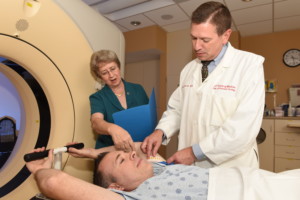The Oldelft simulator was commissioned in February of 1996, replacing the Therasim 750. Installation of the new Oldelft simulator required extensive room modifications as well as enlargement of the simulator area. At the time, the Oldelft Simulix-MC represented the state-of-the-art in modern simulator technology. As with previous simulators in the department, this new simulator is an especially designed x-ray machine that is engineered to replicate the exact capabilities of a linear accelerator or cobalt-60 teletherapy unit.
As with any technology, the Oldelft was replaced with a Diagnostic CT scanner. In contrast to the treatment machines, the CT simulator uses low energy x-rays similar to those used for a chest x-ray to create both fluoroscopic and digital planning images outlining treatment portals. The CT enhances the planning of the treatment by allowing planning of portal directions and setup images without the use of the high-energy beams. Therefore, the planning process can be done carefully and without exposure of high-energy photons to the patients.

The CT scanner is used to take send digital planning images to Dosimity for planning from which the fields will be shaped to exclude normal tissue while delivery maximum dose to the tumor. This ability to delineate normal structures and cancer infiltration is a vital step in the safe and efficient delivery of radiation therapy.
The Diagnostic CT scanner utilizes a pedestal table that can mimic any motion achieved by the actual treatment couches and its cantilever design allow for the ability to achieve unique directional fields, which are employed in three-dimensional conformal therapy. The gantry on the simulator has multiple reliability and accuracy systems including collision and guidance systems in a high-quality digital unit. These features add to the ideal situation of near perfect mimicking of actual treatment. The expanded physical space where the simulator resides allows for storage and implementation of the more modern immobilization and imaging devices. Custom immobilization devices allow for stability, reproducibility and overall greater accuracy of treatments.
